Donation to

Sponsored by

Archive Home Page
Previous Exhibition Following Exhibition
St. Margaret's Hall, Coniston Road, Hatherley, Cheltenham, GL51 3NU
Donation to |  | Sponsored by |  |
Descriptions are based on material supplied by the layout owners
American Roundhouse A typical but fictional HO scale representation of a diesel roundhouse shed. Every building and accessory apart from the lights are 3D printed. 1970 to 1980 is the modelled time period which was a turbulent time for American railroad company liquidation and buyout. My favourite 2 companies are represented: Burlington Northern and Chessie System with the odd interloper. I hope you enjoy this simple layout designed to show off many locomotives in a small space. | 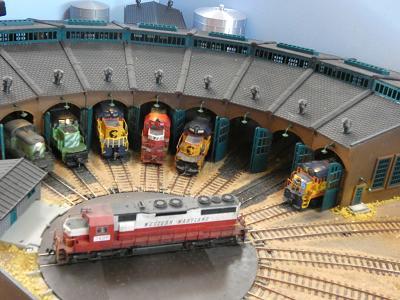 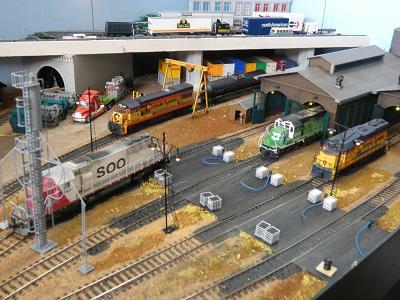 | |
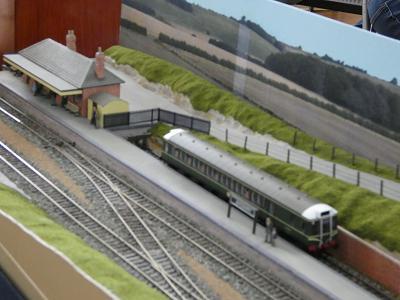 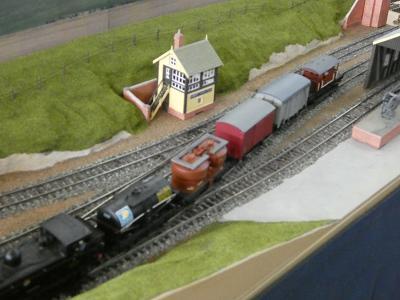 |
The former Midland and South Western Junction Railway (MSWJR) Cheltenham to Andover cross country line was taken over by the Great Wester Railway (GWR) in 1923 but was eventually closed by British Railway (BR) in September 1961. Avebury, the layout has been built to show a fictional branch of the MSWJR. The only actual branch terminus at Tidworth was too spacious to model in a limited space so Avebury was settled on as a place where a branch from Marlborough being built to meet up with the nearby Calne branch could have terminated due to lack of finance, a perennial problem for the "Tiddly Dyke"! The road bridge covering the board joint hinges is a much shortened version of the long many arched bridge that still, just about, stands at the site of the former South Cerney station. On the layout this carries the A361 Devizes Road over the station throat, the station itself sits on the site of the current car park, I have tried to give an idea of the open downland scenery that is so much a feature of North Wiltshire. The station building, signal box and goods shed were inspired by structures at Collingbourne, Foss Cross and Cricklade. | |
Bunkers Lane The Leighton Buzzard Light Railway inspired me to build this layout. I visited the line and was fascinated by a narrow gauge line running through a 1960's and 1970's housing development. The town still has a sizeable quarry industry, with good enough quality building sand to export to Egypt. My model is of a fictitious 18 inch gauge line built to the west of the standard gauge main line that would have been the destination for loaded sand trains. I decided that the mid 1980's was a good time-frame for the model; the preservation society, formed in the late 1960's, has shared the line with the sand companies initially but by 1982 sand was only being shipped by road lorries. The layout has a backscene running down the length of the two scenic boards; the layout is 9 feet long but trains run through a 14 foot scenic section. The baseboards are built from 6mm ply. Bunker Lane is controlled using a Digitrax DCC Command Station with Uhlenbrock Daisy 2 wireless throttles; track is Peco 009 with Cobalt IP Digital point motors. The control systems, lights and sound are built into the three boards to reduce the layout setup time. The photographic backdrops were produced by a commercial printing firm each from a panorama of 6 images. The rolling stock is a mixture of kits, scratch building and 3D printing with some items bashed from parts I have collected over the last few years. Structures are built from styrene, wood, brass, card and glass. I hope that it captures the feel of the quirky prototype, the wonderful Leighton Buzzard Railway. | 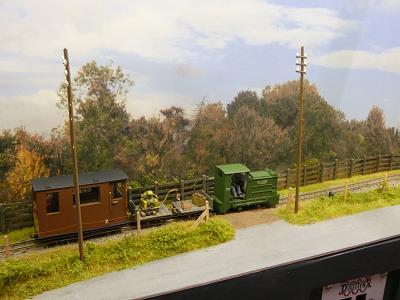 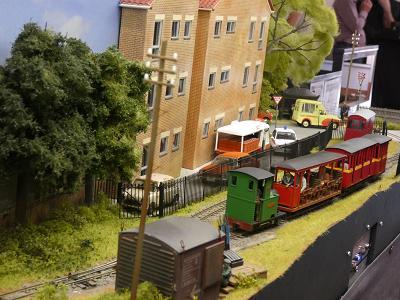 | |
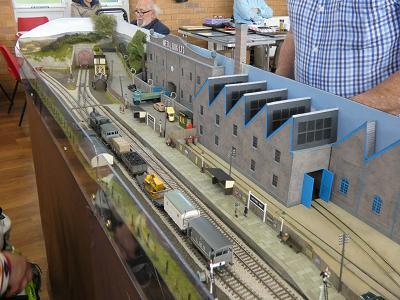 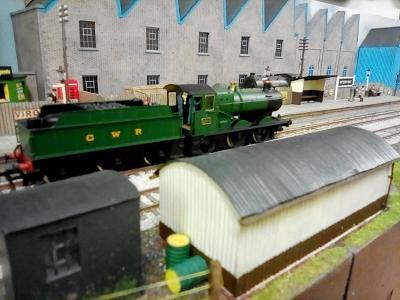 |
Factory Halt is a fictitious layout set in the era of the late 1940's to early 1950's on the edge of the industrial Midlands. The single line was jointly run by the former Great Western Railway (GWR) and London Midland Scottish (LMS).
A short distance beyond the road overbridge, companies travelled on their own metals, as indicated by the bracket signals. During World War Two the tunnel was bombed and suffered extensive damage. The line now terminates at the factory, a water tower and coal stage were installed in front of the now bricked up tunnel entrance for small tank engines to be replenished for the return journey. Motive power and rolling stock carrying the old company logos can still be seen along with the new British Railways liveried engines and wagons. Occasionally the halt's run around loop will be used by trains from the old GWR line to access the former LMS metals and vice versa. I originally built the layout to be displayed for the Rhondda Model Railway Club of which I was a member for thirty years. The layout is exhibited today in memory of the many members and good friends who have passed away since 2020. | |
Farmer's Drove The layout is set on a single track branch across the Fens linking Spalding and March and is set in the period late 1970's to early 1980's. It was built mainly in one year for a challenge between a group of friends, and it is the most non urban layout Steve Farmer has ever built. It depicts a small station on the Fens with Keelings grain taking over the old goods yard and expanding their empire. Traffic seen is typical of trains in the area with passenger services run by Diesel Multiple Units and trip workings to the grain sidings. Many types of trains also pass over the line on their journey. The name for the layout is taken from the name of the signal box controlling the road crossing the road being Farmers Drove, which coincidentally part of it contains Steve's second name. An article regarding the layout and its construction was featured in November 2019 issue of Railway Modeler. | 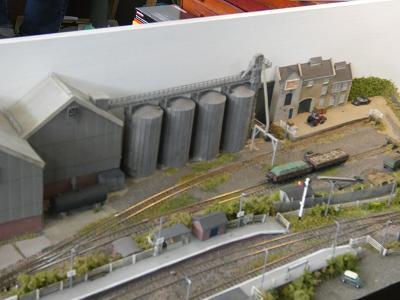 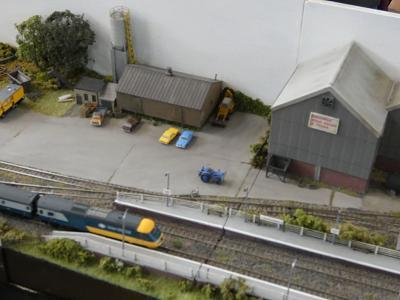 | |
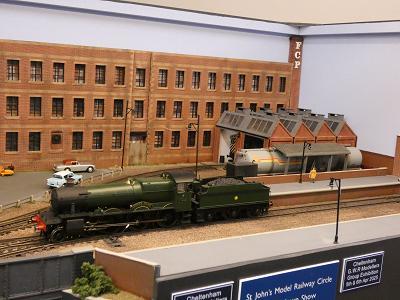 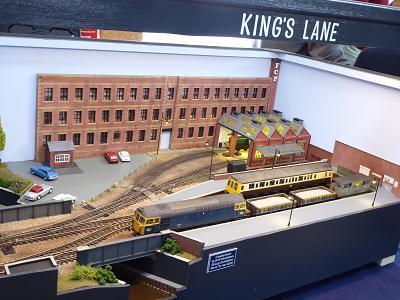 |
King's Lane is a micro shunting puzzle layout in OO gauge. It is the owner's first layout begun when he was 7 years old. It has a small station, fuelling point and engine shed. The design has been left deliberately generic so that a range of stock can be used to represent different regions or eras. The layout uses Peco code 100 track, all of which is second hand. Structures are a mixture of plastic and laser cut wooden kits with additional details added. Stock is an eclectic mixture of Bachmann, Hornby, Heljan or Kit-built. The layout is operated on DCC using an NCE Powercab. | |
Pirton Sidings Pirton Sidings was on the Birmingham to Gloucester main line. The layout features Pirton Signal box, level crossing and sidings together with Wadborough station. It was originally built to show case the Hornby R8553 Holy Trinity church model which is actually a pretty accurate replica of St. Peters Church in Pirton, with its distinctive black and white tower. The layout is exhibited by the PW Gang (Pirton and Wadborough) and features operations from the 1950's and 1960's. | 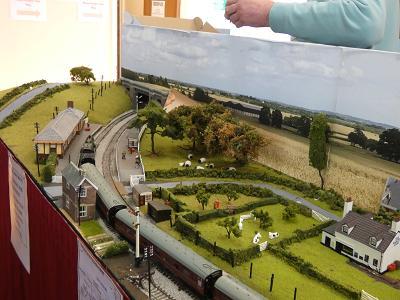 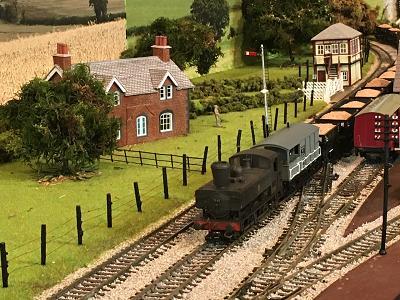 | |
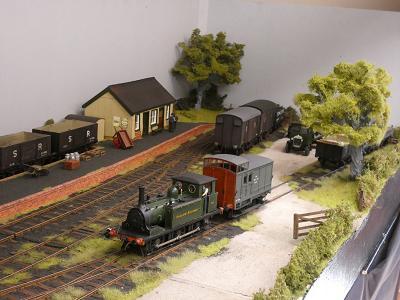 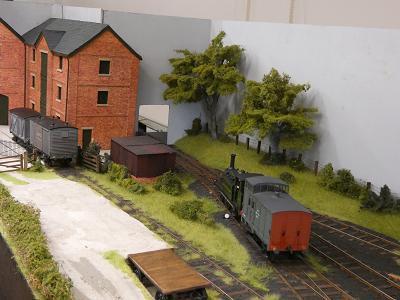 |
Hadlow Light Railway Plaxtol Road is the terminus of the line from Hadlow, serving the Winfield Flour Mill and the needs of the local community. One of many light railways controlled by Colonel H.F. Stephens and his successor W.H Austen. The layout represents the railway running in the 1930's, using second-hand or hired in locomotives and stock, with the minimum of staff and maintenance to keep things going. The Hadlow is run in conjunction with the Kent and East Sussex Light Railway, another of the Colonel's lines nearby. The main traffic is from the mill, some goods and milk with a minimal passenger service for the local population. | |
Portishead TMD This layout is based on Portishead Railway if it had remained open and developed into a modern Deutsche Bahn/ English, Welsh, Scottish (DB/EWS) and Direct Railway Services (DRS) Depot to service Portbury and Portishead Docks. It is a full DCC sound OO gauge layout. It contains a four row engine shed with two central inspection pits. There is also a four bay refuelling station and fuel delivery area. The layout is fully weathered, with full working yard lights and signals. it hosts a range of locomotives and rolling stock dating from the year 2000 up to the present day, as well as rail charter locomotives. | 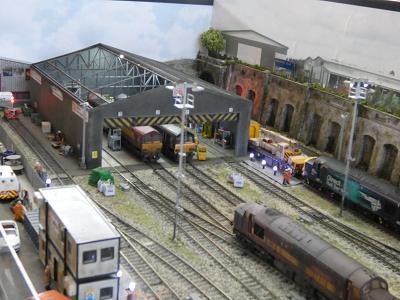 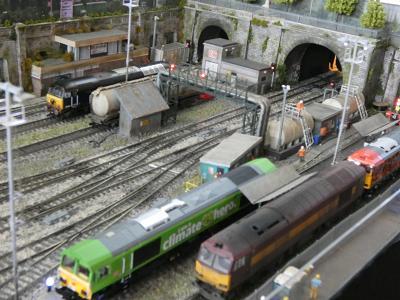 | |
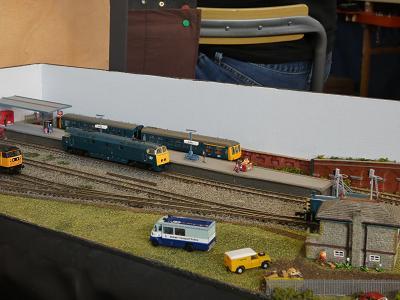  |
St Wick is an N gauge layout with a two platform station and small locomotive servicing shed. The layout is 5 feet by 1 foot and can be set up on a 6 foot table. The original idea behind this model railway was to design a layout which could be set up quickly and taken down within 15 minutes whilst maximizing the small space available on the main board. The track, points and point motors are all Peco and the stock used is a mixture of Dapol and Graham Farish based around the 1980's and 1990's. The layout is owned by members of the Sodbury Vale Model Railway Club based just outside Bristol. For further information visit www.sodburyvalemrc.co.uk | |
Thomas We would like to thank Trevor Hallam for looking after the Thomas Layout for many years at our exhibitions and also for refurbishing it at his expense. Unfortunately because of ill health Trevor is no longer able to continue so it was decided to offer Thomas free of charge to Hucclecote Railway Modellers on condition they bring it to all of our future exhibitions. This is the model railway where Children can become Engine Drivers on the Island of Sodor and has of course been inspired by the Reverend Audrey books. Our Thomas and Friends layout has been built for ten years now and in that time we hope it has encouraged many new railway enthusiasts to build a train set of their own. Originally it was intended as a space filler at shows so needed to be small, easy to transport and have a simple track plan, easy for small children to operate. After its first appearance it was clear this model railway would have to be included at all our exhibitions. It incorporates a tunnel, station, level crossing together with locomotive and goods facilities. Train drivers should look out for many of the popular characters; Henry, Percy, Toby, Cranky, the Troublesome Trucks, not forgetting the Sir Topham Hatt better known as the Fat Controller. The famous anthropomorphised rolling stock is mostly from the Thomas range and we are sure most of the adults and all the kids will love it. Happy Driving, but please observe the track speed limits. | 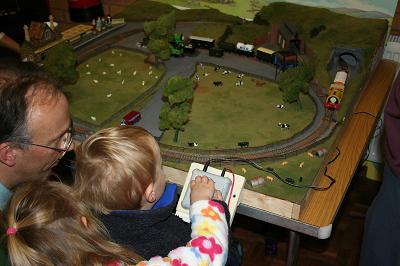  | |
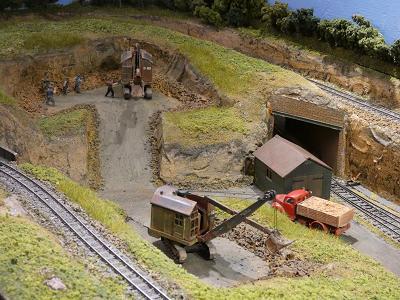 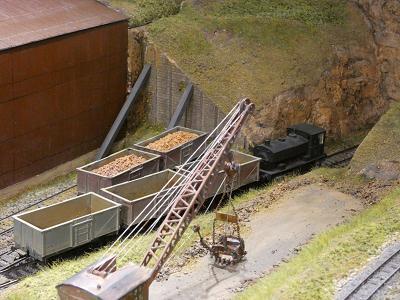 |
Welford Coppice is a typical Ironstone railway which is set in the East Midlands of the late 1950's. Ironstone extraction was a fairly basic operation. The topsoil or overburden, was removed by dragline and dumped in a adjacent field. the ironstone was then removed by huge excavators and transported by rail to blast furnaces such as at Corby, Bilston or South Wales. Rails in the fields were lightly laid and frequently moved and often a narrow gauge railway would bring trains of ore from outlying areas to an exchange point where they would be tipped into standard gauge wagons and marshalled into trains for onward transportation. After the field of ore has been exhausted, the topsoil would be returned and the site would return to nature albeit substantially lower than previously. | |
Whitcliffe Quarry Branch This layout is inspired by various locations in the Forest of Dean. Whitcliffe Quarry is an actual place to the south-west of Coleford. The prototype is a lot larger than the model, I have had to down size the stone crushing and storage plant to a much reduced version of the real thing. Fred Watkins was the local entrepreneur who operated the quarry, along with the engineering works and scrapyard at the end of the real life Sling branch, using modellers licence I have placed all the points of interest adjacent to the quarry complex. The layout also features the sand siding, plus an abandoned horse-drawn tramway wharf for loading stone blocks from local quarries. This is based on the prototype at Bicslade wharf near Cannop Ponds. Stock operated on the layout is what was actually used on the Coleford branch but is expanded to what could feasibly have been seen if the full service had been maintained until closure of the line to the quarry in 1957. Operation is DC analogue and points are manually operated as in real life. | 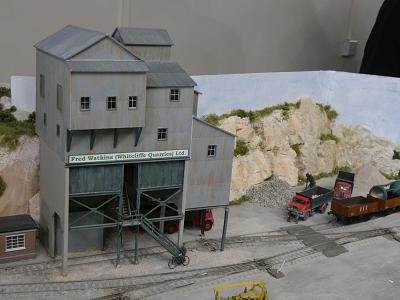 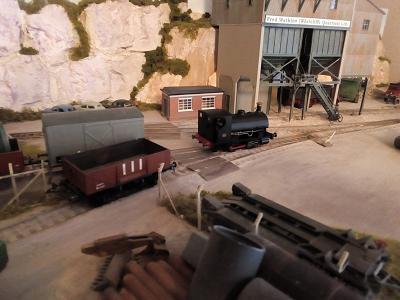 | |
| Displays | ||
Model Bus Federation WEBSITE | NARTM (road transport) WEBSITE | |
Travel 2000 Ltd | Fairground | |
2874 Society | Yorkgate WEBSITE | |
| Modelling Demonstrations | ||
| Mark Begley | Steve Harrod | |
| Trevor Hale | ||
| Trade | ||
| Five Valley Models WEBSITE | Hereford Model Centre WEBSITE | |